'A hidden community': The little-known lives of the women in welfare homes
Adjusting to residential care is hard, but some women in welfare homes say that these facilities have become a home away from home. For others, the goal is to return to the community and regain independence.
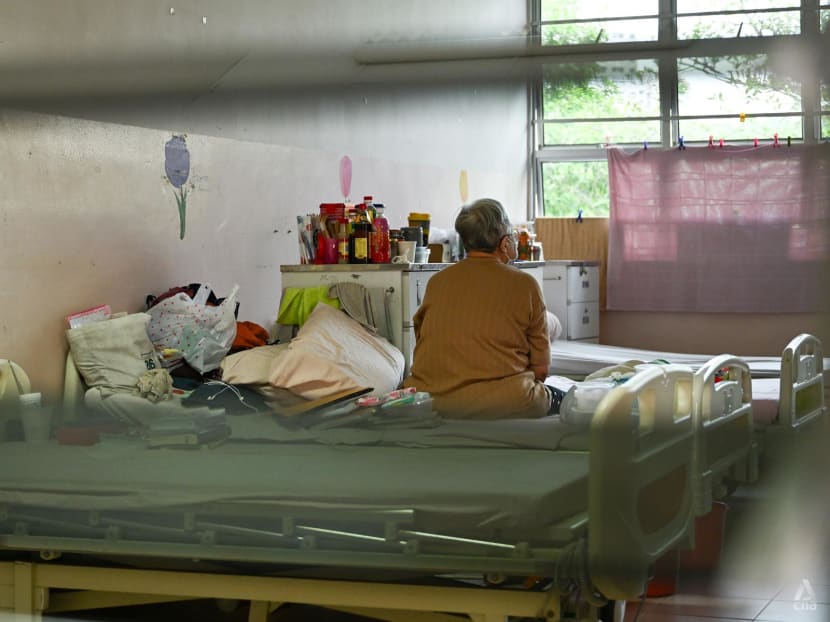
60-year-old Karen (not her real name) is a resident of MWS Christalite Methodist Home. (Photo: CNA/Tan Wen Lin)

This audio is generated by an AI tool.
When Ms Sarah (not her real name) first arrived at a welfare home in Buangkok, she was 35 years old and had been admitted to the Institute for Mental Health (IMH) 48 times since her 20s.
Struggling to manage her health, and with her sister lacking the means to care for her, Ms Sarah ended up sleeping rough outdoors where safety and hygiene were a constant worry.
“I was scared (I would get) molested, scared (I would get) raped,” she recalled. “It was difficult to manage my personal hygiene. That time, in my desperate moment, I would bathe at a coffee shop, shoplift from a pharmacy – but that's not me.”
Her first days in the welfare home, despite its promise of shelter and medical help, were marked by sadness and isolation.
“When I was admitted, at that moment, I felt like nobody (would) take care of me,” she said in a choked voice.
Now 42, she has lived for about seven years in Thuja Home at Pelangi Village, an all-female welfare home run by social service agency 4S.
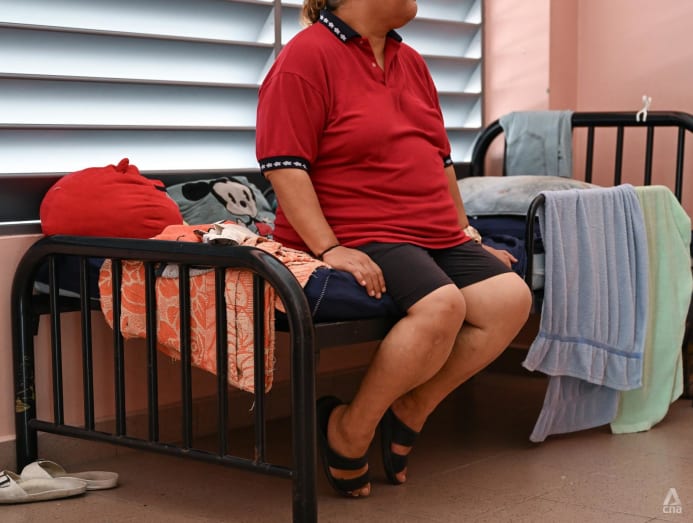
There are 11 welfare homes across Singapore, managed by social service agencies under the supervision of the Ministry of Social and Family Development (MSF). Admission is subject to a “social investigation” by the ministry under the Destitute Persons Act.
In response to queries by CNA TODAY, an MSF spokesperson said that four of the 11 welfare homes take in both male and female residents, while one home takes in female residents only. The remaining six homes take in male residents only.
The ministry added that there close to 1,600 residents across the 11 welfare homes and of that number 20 per cent are female.
Thuja Home at Pelangi Village is the only women-only welfare home in Singapore, currently housing around 190 residents.
Women are also the minority in mixed homes. At MWS Christalite Methodist Home in Marsiling, for instance, only about 15 per cent of its residents are women. At Bukit Batok Home for the Aged, around 33 per cent – or 38 out of 115 residents – are female.
Though small in number, women in these settings often face complex challenges, with many having endured years of neglect, trauma or illness.
Seven women staying in welfare homes told CNA TODAY how adjustment to a round-the-clock residential environment, living apart from their former communities, can be jarring.
Residents at these homes cannot be named due to the sensitive circumstances of their admission and stay.
Single mother Karen (not her real name), 60, never imagined that she would live in a welfare home after growing up in a “very comfortable home”.
“When I entered here, I had no idea what a destitute home was,” she said, having lived in the MWS Christalite Methodist Home for around a year. She has limited contact with her adult son.
Yet, despite initial struggles, many of the women in welfare homes told CNA TODAY of the improvements in their health, the friendships they had built and a sense of stability they had not known in years.
Contrary to the common perception that residents have been abandoned in a place of last resort, Ms Sarah said: “If I didn’t stay here the last seven years, I would be a lot worse than I am now.
“People have that stigma that a welfare home is a very nasty place or that you are alone. It’s a very nice, cosy place for us to think better. Here, there are many people who care for us.”
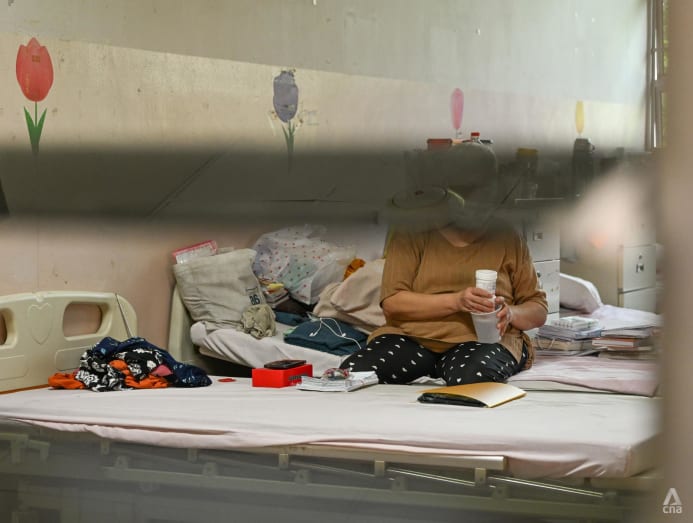
WHY THEY GO TO WELFARE HOMES
Methodist Welfare Services (MWS) said that generally, a person's admission into a welfare home, which is for both men and women, is often driven by difficult circumstances “beyond an individual’s control”.
Neglect and cruelty are common experiences among the older women it sees, and many residents have been abandoned by family members due to age, disability and illness.
More male residents tend to have estranged family relationships, arising from factors such as absentee parenting, repeated jail time, substance abuse, domestic violence or extramarital affairs.
Female residents, on the other hand, need full-time residential care because of “poorer support systems”, MWS said.
“In some cases, people have fallen into debt or been financially exploited by relatives or partners. Others are survivors of domestic violence or abuse – both physical and emotional – or have gone through divorce or separation without financial support.”
Ms Kelly (not her real name), 61, has resided in Thuja Home at Pelangi Village for over two years, after a long period of housing instability, including rough sleeping at a staircase in Bedok and a stay in IMH.
Twice divorced and estranged from her children and family, she has made peace with her solitude.
“I try not to think that (my family) will come to see me. I just have this dream that they are healthy and that they are living in a good way,” she said.
She kept to herself in her first year at the home, but she has since found a good friend who taught her how to appreciate new hobbies.
“I was so happy to have a place where I would have a cupboard and a small table. I never thought there would be room for people like us. I thought everyone had a family only,” Ms Kelly said.
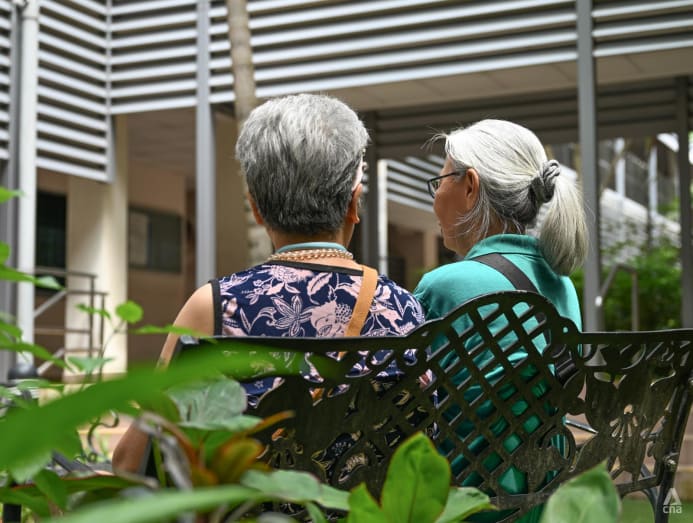
For Madam Mary (not her real name), a single woman in her mid-70s, she found a place in MWS Christalite Methodist Home after years of collecting and selling cardboard from coffee shops and stores. Her only sibling living in Singapore, a younger brother, now resides in another welfare home.
“Sleeping outside is very dangerous, some people sleep outside and get cheated and end up pregnant. But living here is very good. Here, there’s food, there’s a place to stay,” she said in Mandarin.
Ms Michelle Koh, assistant superintendent of Bukit Batok Home for the Aged, said female residents are typically admitted due to psychiatric conditions coupled with a lack of family support, or situations where family members are unable to cope with caregiving responsibilities.
She noted that another key factor determining the admission of both male and female residents to the welfare home is their age profile, combined with the lack of alternative accommodation and the absence of family support.
At Thuja Home at Pelangi Village, however, superintendent Melissa Maniam is seeing an increase in younger women who are in their 30s and 40s entering the welfare home.
“This means that they are often more lucid, they know of their rights and freedoms. So they are unable to really understand why they are placed in a home,” Ms Maniam said.
Dr Kelvin Tan Cheng Kian from the Singapore University of Social Sciences (SUSS) said this trend may continue as more Singaporeans remain single. Without alternative housing options, institutional care could become the fallback for those with no safety net.
Despite the uptick, the female population in welfare homes remains significantly smaller than that of men, a trend that reflects broader gender norms, experts said.
Dr Tan, head of SUSS’ minor in applied ageing studies, explained that women bearing the brunt of domestic responsibilities often foster closer family ties.
“Due to this disparity of family roles during their active lives, men are more distant from their children in the post-retirement or latter years, resulting in them ending up in institutional care,” Dr Tan said.
Dr Tan Ern Ser, an adjunct principal research fellow and academic adviser at The Social Lab of the Institute of Policy Studies, also suggested that some women who may have good reasons to turn to welfare homes resist doing so, because their identity and sense of security and dependency are centred on being part of a family unit, even a dysfunctional one.
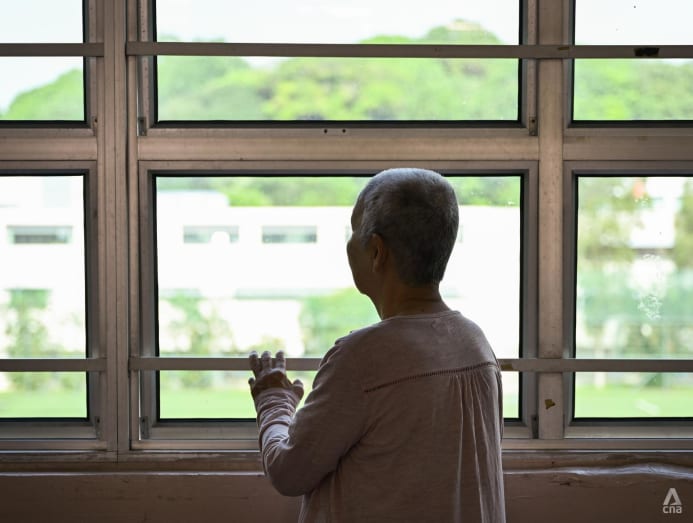
LIFE IN A WELFARE HOME
Beyond essential services such as meals and medical care, many welfare homes aim to provide meaningful engagement, from recreational activities to work schemes and outings.
"Residents are provided support through holistic intervention programmes, such as life skills training and setting of employment goals. This is to ensure that they are successfully rehabilitated and can eventually reintegrate back into the community," said MSF.
Contrary to some residents’ fears that living in a welfare home might be like a “jail”, Mr Adrian Ng, a social worker at Bukit Batok Home for the Aged, said the welfare home makes an effort to ensure residents exercise independence.
For example, residents may take part in a home earning scheme – light duties within the home that come with a small allowance.
Some residents are also nominated for community outings under a buddy system, providing some freedom to travel and buy things with the allowance they have earned.
“It gives residents a sense of purpose and they get to contribute to the home. They gain some allowance and benefits like outings, so it keeps them going,” Mr Ng said.
One such resident is Madam Liza (not her real name), 69, who has lived in Bukit Batok Home for the Aged for a decade.
She said: “The first time I came here, I felt sad, because I didn't know the place and my family also didn't know I stayed here. But now it’s different.”
She finds joy in her role as a receptionist at the front counter for four hours every day – a job that reminds her of her former occupation as a security officer.
“I stay here, I feel happy, because many people can take care of me. I have many friends, I can join the activities,” she said.
Mr Alvin Chua, lecturer in the department of social work at the National University of Singapore, said that the key challenge in institutional care is the loss of autonomy and the need to comply with rules.
The nature of institutional care operations and the responsibility of the management to ensure safety among residents often leaves little to no room for individualisation, he added.
Over at MWS Christalite Methodist Home, the welfare home has observed that many of its female residents grapple with loneliness, depression and a sense of hopelessness in coping with the past trauma, mental health conditions or familial estrangement that led to their admission.
“Structured routines and restricted movement outside the facility, though necessary for ensuring safety and optimising care plans, can further affect their mental well-being by limiting autonomy,” MWS said.
To address this, the welfare home has designed programmes such as Colour Me Beautiful, which aims to increase female residents' social engagement and provide a safe space for them to reflect on their personal identity.
In the six-week pilot programme, female residents took part in “self-expression activities” including fashion styling, floral arrangement and skincare application paired with group discussions.
“Post-programme surveys reported improved mood, energy and self-esteem among the participants,” MWS said.
One initially introverted resident, Madam Lucy (not her real name), frequently told staff members that she felt lonely after being admitted late last year.
In one Colour Me Beautiful session about fashion styling, Mdm Lucy selected a green scarf and paired it with a pink necklace, then modelled her selections for the group. “It’s very enlightening. I like almost everything about the course. It makes me feel more normal,” she said.
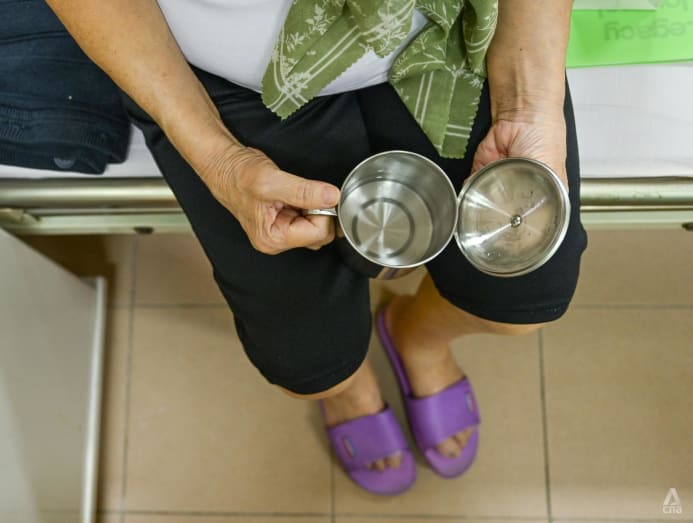
In CNA TODAY’s conversations with women in welfare homes, many also spoke about friendships and fallouts – a reflection, social workers said, of how female residents often place great weight on emotional connection in the welfare home environment.
Ms Maniam, the superintendent from Thuja Home at Pelangi Village, said its residents value interpersonal relationships strongly.
“There’ll be a constant theme between a few residents, where one will say, ‘They don’t like me’, and because of that, she can’t function and cannot even work.”
Agreeing, Mr Ng from Bukit Batok Home for the Aged said: “Female residents tend to want to get along well with their counterparts. They may have verbal quarrels, complaining, ‘Oh, this person says this', but they will try and get along.”
Many residents often require ongoing emotional support, particularly in managing interpersonal relationships – be it from their past or with peers in the home.
Ms Maniam said: “Sometimes when we get to the office, (residents) are crying, sitting outside of the office and saying, ‘Nobody wants me anymore’. My colleagues and I spend a lot of time talking to them, trying to calm them down.
“It’s something we cannot brush away, because all these emotional (moments) are leading to a bigger picture, like their relationship with other people, social communication, behaviour and intervention plan.”
Ms Sherry Soon, executive director of Be Kind SG, a social service agency that aims to foster an inclusive society for persons with disabilities, including those with intellectual disabilities and autism spectrum disorder, has observed female residents exhibiting a “greater need for an affectionate type of relationship” with volunteers.
The charity conducts monthly visits to a welfare home, during which it engages residents with a programme that includes dance exercises, guest segments, colouring, singing and music.
While she has witnessed friendships bloom in the welfare home environment, she has also seen interpersonal conflict between residents.
However, she said that this was to be expected, since life in a residential home is a “microcosm of society”.
“There’s a misconception that welfare homes are sad and depressing. Not to say there aren’t challenges, but it is like a community, a place where people can find friendship,” Ms Soon added.
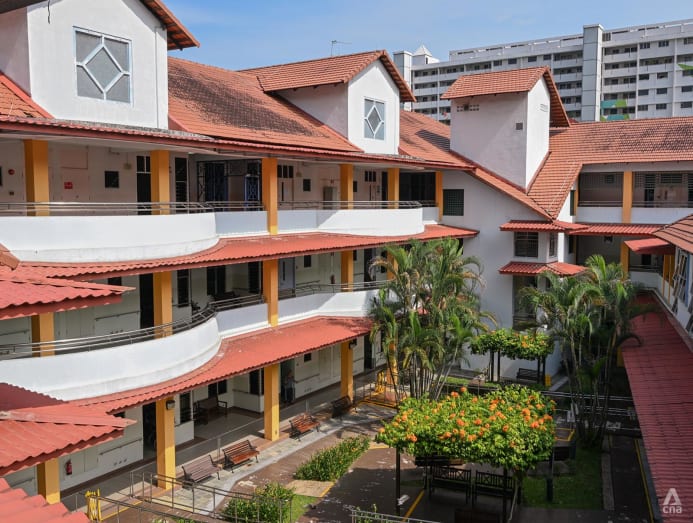
HIDDEN, NOT HELPLESS
Life inside a welfare home may be full of activity, but the women who stay in such environments – and the facilities themselves – often remain outside of the public eye.
Ms Soon from Be Kind SG said some volunteers were initially unaware that such homes even existed.
“They are really a hidden community. We have had volunteers who live near the welfare home and they didn’t know what the home was about,” Ms Soon recalled.
While donations are important, what makes a difference is companionship, for example through volunteering for events, to create “beautiful memories” for the people in welfare homes, Ms Soon said.
Ms Koh from the Bukit Batok Home for the Aged said the public may not fully understand the complex circumstances that lead women to reside in welfare homes, and their enduring desire for dignity and connection.
“They are not simply recipients of care – they are individuals with histories, preferences and the capacity to heal and grow when given the right support.”
Similarly, MWS said the “immense strength” of the residents in surviving abandonment, abuse, poverty or social stigma is often overlooked.
“These women are not helpless – they are often resourceful but worn down by systemic barriers and a lack of support. With trust, dignity and opportunity, many can rebuild their lives,” MWS added.
For some women in welfare homes, what rebuilding looks like is clear: to return to the community and regain independence.
Ms Sarah, the resident of Thuja Home at Pelangi Village, is working towards living in a rental flat under the public housing authority's Joint Singles Scheme.
“I feel thankful staying here, because I can learn how to be independent. A few years back, I didn’t know anything about self-regulation. But I went to a course and one of the officers taught me to (manage my emotions), how to float, not drown,” Ms Sarah said.
Under a scheme at the home, she has found part-time employment as a cafe retail assistant, which suits her schedule of frequent medical appointments.
“I left (secondary school) because of medical reasons. I still wanted to study but I had no choice then. Now, staying here, I work hard, get some savings and can continue from then.”
Though giving residents employment skills is important in helping them execute plans for a new life, Mr Chua the lecturer from NUS cautioned that many residents carry emotional burdens that are not easily resolved.
“They may seem better and be ready for discharge after the interventions. Yet, it is not uncommon to have these residents coming back into the system shortly after that.”
He pointed to the need for therapeutic support – such as counselling, art or play therapy – and structured aftercare to support a smooth transition.
Ms Maniam observed that reintegration with one’s family was “very rare”. She has encountered only one or two successful cases over the years.
Reintegration can be “especially complex” for female residents given the social, economic and cultural disadvantages and limited family support many residents have, MWS said.
Each year, its welfare home has reintegrated around 5 per cent of the residents into the community – only one-fifth of whom are female.
“Our aim is to improve their overall quality of life throughout their stay. However, for many residents, reintegration into the community is not a likely outcome – not due to a lack of will, but because of complex life circumstances and practical constraints,” MWS added.
Still, for some other female residents, fulfilment is not found in leaving, but in enjoying life within the four walls of the welfare home, where they have forged healthy routines, friendships and a sense of security that may have eluded them elsewhere.
One of them is Ms Sandy (not her real name), 57, who has stayed at Thuja Home at Pelangi Village for more than nine years.
Diagnosed with bipolar disorder, she said that staying at the home has helped her feel “very stable”.
Adjusting to living with strangers was initially a struggle, she admitted, and even now and then, there are quarrels in her dormitory, which sleeps eight residents.
“Sometimes, we quarrel then patch back. We automatically patch back,” she said. She is buoyed by the friendships she made, including with Ms Kelly who spends time doing colouring activities with her – Ms Sandy's favourite hobby.
“At my age, I have nowhere to go already. I feel happy now. I feel like it’s very nice here. It feels like a home,” Ms Sandy added.










